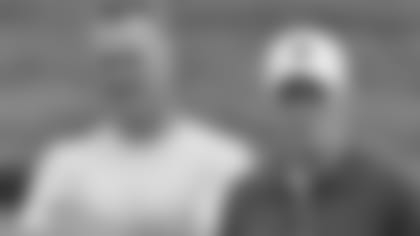This story appears in the current issue of Dallas Cowboys Star Magazine. To purchase an individual copy, please click here. For subscription information, please click here.
Last month at the NFL owners meetings in Orlando, the Cowboys learned they were receiving a few compensatory picks for the 2014 NFL Draft.
Immediately, the key number on everyone's mind wasn't three, the number of extra picks they were acquiring, and it wasn't seven, the round in which all of the additional picks would fall.
Instead, the number most often referred to was 11, the number of total picks in the Cowboys' pocket for this 2014 upcoming draft.
Eleven, the most the Cowboys have had since … dare we bring it up … the 2009 draft.
As quickly as fans or staff members want to get excited about the near-dozen picks in the stable, it's hard not to recall the Cowboys' draft of just five years ago. Many believe it's the failure of 2009 – when 12 players were taken, but not one remains on the roster today, and just three are even still in the league – that has led to the team's recent run of mediocrity.
Of those 12 drafted in 2009, none of whom came in the first or second rounds, not a single player ever became a primary starter for the Cowboys on offense or defense. David Buehler, a fifth-round pick drafted mainly for his kickoff duties, became the full-time kicker for one season.
Other than that, the Cowboys picked 12 players who were complete non-factors.
So how are things going to be different in 2014? Well, the club is hoping it has learned a few lessons along the way, particularly from the mistakes that were made in the draft five years ago.
For starters, the Cowboys didn't have a first-round pick because of another questionable move made the previous fall. That's when Dallas traded for wide receiver Roy Williams, in exchange giving Detroit its first-round pick in 2009, along with third- and sixth-round selections. Needless to say, Williams didn't live up to the hype on the field and wasn't worth the draft ammo the Cowboys gave up to get him.
Making matters worse, recent history has shown that the Cowboys have not fared well overall in drafts when they haven't had a selection in the first round. The team didn't have a first-rounder in 2004, and its best choice that year was Patrick Crayton in the seventh round. In 2001, no first-round pick netted five players who eventually went on to play in the Arena Football League, including Quincy Carter, who could be called the most productive prospect from that draft class.
Without a first-round pick in 2000, sixth-rounder Mario Edwards proved to be the best from that group. And in 1995 and 1996, the Cowboys also didn't have first-round picks and the best players coming out of those drafts were Eric Bjornson and Randall Godfrey, respectively, the latter a good linebacker who eventually got paid in Tennessee.
So knowing all of that, the Cowboys still entered 2009 with the hopes of turning around their draft-day struggles.
Instead, they came up with perhaps the worst draft in franchise history.
Every team in every draft ends up leaving a great player on the board to go in a different direction. That's why the draft is so intriguing, and is why teams that have the greatest success in January and February are actually set up by their decisions in April, and now May with the draft having been moved back this year.
In 2009, the Cowboys held the 51st pick, a later second-rounder, and had their sights set on about eight players they liked, three of whom eventually went on to make the Pro Bowl, including Philadelphia running back LeSean McCoy.
The Cowboys had a first-round grade on McCoy, who was a dynamic collegiate player at Pittsburgh. (Although it had been more than 30 years, the Cowboys made it work with a Pitt running back before in Tony Dorsett.) The worry in taking McCoy, however, wasn't about him, but rather where he'd fit into the scheme.
Just one year prior, the Cowboys had taken Felix Jones in the first round of the 2008 draft, as well as Tashard Choice in the fourth round. Not to mention they had also signed Marion Barber to a seven-year, $45 million contract the previous summer.
So the Cowboys passed on McCoy. They also passed on Oklahoma tackle Phil Loadholt, whose minor injury concern was enough to scare them off.
Still, the Cowboys did like players such as Connor Barwin, Alex Mack and Max Unger. Surely, one of those guys would be around at No. 51. Unfortunately, that would not be the case. All of them, along with a few others of interest, started coming off the board at a rapid pace, according to Cowboys college scouting coordinator Chris Hall.
"The next thing you know, Connor Barwin went off the board, Alex Mack went off the board," Hall said. "We had six or seven guys and they all went off – ding, ding, ding, ding, ding. All gone. We felt good about six picks, and they all went. We didn't want to take (McCoy) and couldn't pull the trigger on Loadholt, so we traded."
It's a trade that Hall has written down on a piece of paper and pinned up on a bulletin board that hangs above his desk in his office.
"We traded the 51st pick for the 75th and 110th pick," Hall said. "We lost about 110 points on any draft chart you look at. We left a first-round pick in LeSean McCoy on the board. We didn't take Phil Loadholt, who had a higher grade. He would've been a right tackle and who knows what happens with Doug Free. Loadholt might have been our right guard all these years. You just never know."
The 75th pick turned out to be Western Illinois linebacker Jason Williams and 110 went to offensive tackle Robert Brewster, who played one game and is currently out of the league. Williams played 10 games over a two-year span with the Cowboys before being released. He has spent the last three years as a role player for the Carolina Panthers.
And from there, it didn't get much better for the Cowboys, who took chances on players such as Stephen McGee, Victor Butler, Buehler and John Phillips – and those are the guys who actually played and contributed. Others such as Brandon Williams, Stephen Hodge, Mike Mickens, DeAngelo Smith and Manuel Johnson barely saw the field, if they did at all.
The lesson learned from the 2009 draft is to stick to the board whenever possible, especially in the early rounds. Even though Hall admits it's easier said than done when it involves convincing a head coach that value over need is the way to go.
"The coach wants to win now. Stacking up another good running back, when you need linemen or defensive help, in their mind, it's not going to help," Hall said. "But if you take 'A' players instead of taking 'B' players, ultimately you're going to make your team better. And I think that's the lesson we learned. It doesn't matter what you have on your roster, you take a first-round pick if he's sitting there."
The 2009 draft was so powerful, it actually affected some of the decisions made the next year, albeit both good and bad. [embedded_ad]
On a positive note, the Cowboys were burned by sitting back at No. 51 and waiting for players such as Unger and Mack to fall to them. Their first two picks in 2010, wide receiver Dez Bryant and linebacker Sean Lee, were both drafted after the Cowboys moved up a few spots when they feared they would be drafted by other teams. Dallas went from pick 27 to 24, jumping Baltimore and take Bryant. Later in the draft, they went up from 59 to 55 to get Lee, a player with a first-round grade who had medical concerns. Those issues have obviously been validated with his consistent injury history during his four years in Dallas, but Lee's playmaking ability has also been visible as well.
One of the carryovers of the 2009 draft that wasn't so positive, though, occurred with a college teammate of Lee's, a player on whom the Cowboys also had a first-round grade. Penn State linebacker NoVorro Bowman had character issues that scared off a few teams. But as the story goes, early in the third round some of the Cowboys scouts were urging Jerry Jones to trade back into the third round and take Bowman. Even though they didn't have a third-rounder because of the Lee deal, it was possible to maneuver other picks to move back up.
However, head coach Wade Phillips apparently nixed the idea, saying he didn't want to be "stacked up" at linebacker because the Cowboys already had Williams and had just drafted Lee. Instead, Bowman went to San Francisco with the 91st pick and has been paired up with Patrick Willis to create a Pro Bowl combo.
That's just another example how one draft can affect another.
This time around, however, the Cowboys are hoping the 2009 draft, and the 12 disappointing picks that came from it, will have a positive impact in 2014.















